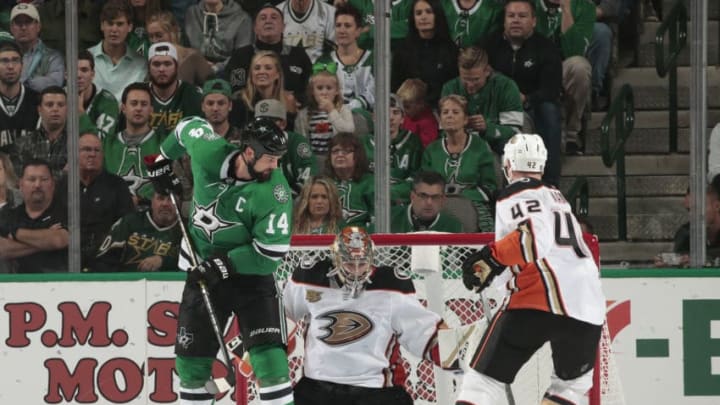Dallas Stars Set Records With Unreal Second Period vs. Anaheim

Last Saturday night, the Dallas Stars found themselves in a 3-0 hole against the Anaheim Ducks midway through the second period. But by the end of the game, they had flipped the script and found their way into the history books in the process.
If Saturday night’s game had ended halfway through, the Dallas Stars might be in a really disappointing spot right about now. To lose to Anaheim in poor fashion and follow it up with disappointing losses to Ottawa and New Jersey would have Dallas on a four-game losing streak at the moment and in a serious rut.
I had almost given up on taking notes altogether when the Stars began clawing back . About six minutes into the second period the Stars had 25 shots, 14 more than the Ducks.
Then, all of a sudden, the Ducks increased their 2-0 lead to 3-0 using a power play goal that Alexander Radulov (who was in the penalty box) seemed a little unhappy with.
That’s when the Stars turned it on. Radulov came back from the penalty box and immediately righted his wrong, scoring a goal to get Dallas on the board. But even with 30 shots, the Stars were still in a 3-1 hole.
That wouldn’t last long, though. With two more goals coming in a span of 2:47, the Stars had knotted the game up thanks to Connor Carrick and Jamie Benn. John Klingberg ended the second period with a power play goal to make it a 4-3 game going into second intermission. That lead held to the end of the game when Radek Faksa scored into an empty net to make it a 5-3 final.
Dallas outshot Anaheim 30-4 in the second period alone, setting a new Dallas Stars record in terms of shots in a period as well as the second-highest shot differential (+26) in franchise history.
What Caused The Dallas Stars’ Second Period Breakout?
In less than 10 minutes the Dallas Stars put up four goals on a similar amount of shots their opponents had taken for their three points. So what changed? Nothing.
The Stars never simply stuck to their attack plan. 30 shots is an impressive number for a team to have at the end of a game. But having them in one period will burn out a goaltender. That’s all the Stars needed to get themselves back in the fight.
How Did The Stars Put Up So Many Shots?
There are a plethora of contributing factors that could have caused the breakout. But it is mainly based on the fact that the Stars kept the puck in the offensive third. Puck possession is key to winning any game. And for how often they were being scored on, it is a major relief that the Stars determined the fate of the puck when it was all said and done.
They took away Anaheim’s offensive pressure and gave Anton Khudobin a chance to rest after a rough first period. Khudobin later noted during the postgame that he could have taken a nap during the middle frame because of how little action he faced.
It is no secret that Tyler Seguin is a sniper and many of the Dallas defensemen have strong, deceptive shots as well. The draw that players like Jamie Benn, Seguin, Radulov, and other forwards have typically allow the Stars’ defenders to pound the puck and play more freely in the offensive zone. Carrick and Klingberg were both able to capitalize on that. And, like mentioned above, Seguin drew enough attention to open Benn up for goal three in the game.
Shooting Is The Stars’ Best Defense Right Now
Shooting puts defenders on their heels and gives energy to players and fans alike. The Dallas Stars are finding ways to win even when missing key players like Stephen Johns. How might they be doing that?
Simply put, defensemen are not as crucial when you’re on offense for a majority of the game. I’m not saying the Stars don’t need Johns. His return can boost some of the team’s poorer areas, like the penalty kill. But that is a topic for another day.
The bottom line is that the Stars can usually find success if they outshoot their opponents. They can find a game winning goal, stage a furious comeback, and take some weight off of their defensemen and goaltender. Jim Montgomery’s relentless offensive style should help them in continuing that push (unless they stay in the rut that held them down in the most recent road trip).
Tests are coming up quickly for their offense. But if they can hold true to their strategy and structure, they should have no trouble producing.